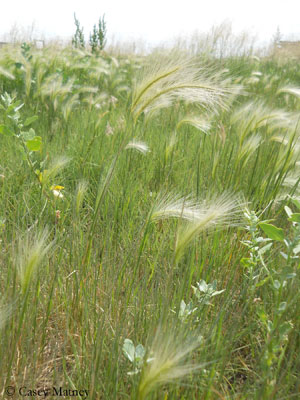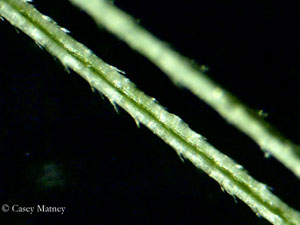by Casey Matney * (12/14)
Quick Facts…
- Foxtail barley is a perennial native bunchgrass that reproduces by seeds and tillering.
- Hay contaminated with Foxtail barley is greatly reduced in value and utility.
- Foxtail and many other barley grasses have sharply-barbed awns that can cause sores at the nose, eyes, and mouth of livestock.
 Figure 1. Foxtail barley growing alongside an irrigation ditch. Figure 1. Foxtail barley growing alongside an irrigation ditch. |
Foxtail barley (Hordeum jubatum) is a showy short-lived native perennial cool season bunchgrass that belongs to the grass tribe Triticeae. It has a shallow root system and reproduces by seeds and tillering. This plant ranges in height from one to three feet tall at maturity. It is often found in pastures, roadsides, meadows, alkaline/saline areas, moist soils and disturbed areas (Figures 1 and 2). In general, it is found more often where water accumulates (seasonally ponded areas, wet meadows and areas near ditches and streams). Foxtail barley is often found to be growing alongside grasses and weedy forbs adapted to wet and/or alkali/saline environments. These associated plants often include bentgrass (Agrostis spp.), inland saltgrass (Distichlis spicata), alkali sacaton (Sporobolus airoides), Kentucky bluegrass (Poa pratensis), basin wildrye (Leymus cinereus), tall wheatgrass (Thinopyrum ponticum), horsetail (Equisetum spp.) and Baltic rush (Juncus balticus).
 Figure 2. Foxtail barley growing in a pasture, an area often ponded during the spring. Figure 2. Foxtail barley growing in a pasture, an area often ponded during the spring. |
Livestock can safely graze foxtail barley prior to seed development. Forage value of this grass is fair to good at this time. Seed production for this grass occurs from late May to August. Foxtail barley at lower elevations (warmer regions) will produce seeds earlier than higher elevations (cooler regions). Grazing this plant after it produces seeds can cause a number of problems for animals. Once seeds form, awns extending from the seed can abrade or become lodged in the skin, mouth, nose and eyes of grazing livestock. Lodging is due to foxtail having small sharp barbs located along the outer edges of the awns (Figure 3). Due to the awns, livestock encountering this plant in a pasture or rangeland situation will avoid grazing it and will seek alternative forage. For these reasons this grass is likely to increase under heavy or continuous grazing while at the same time grasses that are more palatable are likely to decrease.
The barbs on foxtail awns also allow it to easily become lodged in the hair and fur of livestock and wildlife. Once caught on the animal, the seeds can be transported to new areas for colonization or further distributed within areas that they already occupy. Sheep are at high risk for catching these seeds, and the value of their fleece declines when they are contaminated. The value of hay is also affected by the presence of foxtail barley. Unlike in rangeland situations, animals fed hay contaminated by foxtail are unable to avoid eating the plant. Contaminated hay is unsafe for livestock. Livestock that have eaten contaminated hay may show symptoms such as drooling and lack of appetite. Awns may also become visibly lodged in the snout of animals eating the hay. The drooling and lack of appetite is caused by the mouth of the animal being impacted and inflamed by hundreds of awns. For these reasons pastures containing foxtail barley should not be hayed. In addition, hay contaminated with foxtail barley should not be used or sold. There are anecdotal accounts of ranchers processing contaminated hay through a hammermill to decrease the danger of feeding foxtail seeds to animals. However, the effectiveness of this treatment has not been tested and is not recommended.
 Figure 3. Foxtail barley awns at 4X magnification, displaying barbs. Figure 3. Foxtail barley awns at 4X magnification, displaying barbs. |
Movement of contaminated hay offsite to a different location for any purpose, even if not fed to animals, is likely to further spread seed. Areas that are wet in the spring are the most likely to be invaded. Best control of this grass in pastures and rangeland occurs when mechanically and/or chemically controlled (or eliminated) and then reseeded with a more desirable grass species. Although effective, mechanical treatment and seeding may not always be required. In some situations, foxtail may occur in smaller bunches and patches. When this occurs spot treatment with the generic herbicide glyphosate (e.g. Roundup®) can be effective in controlling the plant. Alternatively, when foxtail is more prevalent, mowing or intense grazing timed early in the growing season may reduce the plants ability to produce seeds and may provide some control. Further, where irrigation can be controlled, reducing saturated soil conditions prior to June may decrease the growth and production of foxtail. For more options regarding management or control of foxtail barley, please consult your nearest rangeland or weed Extension specialist.
*Casey Matney, Colorado State University Extension, specialist – range management. 1/12. Revised 12/14.
Colorado State University, U.S. Department of Agriculture, and Colorado counties cooperating. CSU Extension programs are available to all without discrimination. No endorsement of products mentioned is intended nor is criticism implied of products not mentioned.
Go to top of this page.





